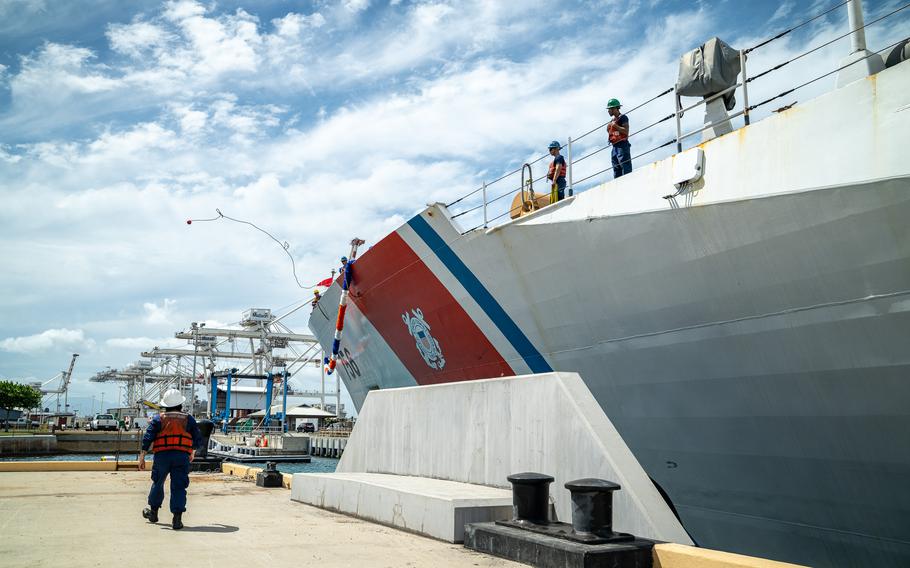
Coast Guard members assigned to the USCGC Kimball throw a heaving line to the pier on Coast Guard Base Honolulu, Hawaii, on May 5, 2025. (U.S. Coast Guard photo)
WASHINGTON — The Coast Guard has lost members faster in recent years than it recruited new ones and the service is not doing enough to address the problem, a federal watchdog found.
The Coast Guard consistently lost more enlisted members than it recruited from 2019 to 2023, the Government Accountability Office reported. The trend turned around in 2024 with retention-focused surveys and expanding recruiting outreach efforts, but the Coast Guard still can’t pinpoint precisely what needs to be done to better recruit and retain members.
As a result, the service is short about 3,000 members and is operating below the workforce level that it deems necessary to meet operational demands.
“The Coast Guard identified some retention issues through surveys. But it needs more data and planning to better target its retention efforts on personnel with the skills and training needed to achieve its mission,” reads a GAO report on retention that was released in April.
Additionally, a recruiting-focused GAO report released Wednesday highlighted the service beat its recruiting target in 2024 after increasing recruiting offices, marketing, and other outreach efforts. But the GAO said the Coast Guard “could do more to assess which of these efforts worked.”
The Coast Guard is a multi-mission maritime military service within the Department of Homeland Security. In 2024, it employed more than 39,000 active-duty service members, of which about 30,600 were enlisted members.
The Coast Guard has used a survey for the past 15 years as its primary way of getting information on why a member may choose to leave the service. But the survey, which is emailed to members, has had a consistently low response rate since 2018. Specifically, the 2023 Career Intention Survey had an overall response rate of 39%, and the response rate for those leaving the service was below 7% in 2021.
The Coast Guard began requiring members to respond to the survey in 2022, though the service has not implemented any kind of enforcement for those who do not respond.
The service also offers various retention incentives, such as pay bonuses for certain jobs and extra points on advancement exams for professional achievements. But because the service is not taking steps to improve survey responses and analyze those responses, the Coast Guard is unable to determine how to hone its retention tactics.
“Without effective mechanisms to increase response rates, the Coast Guard faces challenges with accurately determining the most likely causes for service member separations. This also can affect how well it is able to identify problems and target solutions,” the GAO said.
The GAO found members tend to leave the Coast Guard due to frequent moves, challenges in finding housing and child care, limited pay and a lack of opportunity for career advancement. Because the Coast Guard survey has such low response rates, the answers might not accurately reflect service-wide perspectives, according to the April report.
The Coast Guard recruited 4,400 members in 2024 – 1,000 more than it lost. The GAO, in its May 14 report, pointed to expanded recruiting efforts, including new outreach efforts, sign-on bonuses, and a revision of enlistment eligibility standards.
“But additional opportunities and challenges remain. For example, the Coast Guard has not fully assessed how its initiatives contribute to recruiting results. Additional data collection or analyses, such as determining the cost effectiveness of certain efforts, could help the Coast Guard make evidence-based decisions regarding any further changes needed,” according to the latest report.
Last year, the Coast Guard increased its annual marketing budget to more than $24 million to attract new recruits, compared to just $7.1 million in 2020. The service also opened seven new recruiting offices in 2024, with plans to open seven more in 2025.
The service has also implemented East Coast and West Coast mobile recruiting teams and is partnering with technical schools to allow students lateral entry into the Coast Guard once they are certified.
However, the Coast Guard needs to analyze its recruiting and outreach activities to make better evidence-based decisions about how to revise or further expand its recruiting efforts, the GAO said.
The GAO recommended the Coast Guard develop ways to increase survey response rates and do a better job of analyzing the responses, including weeding out biased answers, to determine whether the responses reflect a service-wide perspective. Additionally, the GAO recommended the Coast Guard further assess how recruiting and outreach activities contribute to the annual recruiting data — specifically, what attracts new recruits to better direct funding.